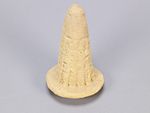Cuneiform Tablet
About this object
History of use
Cones such as these were initially plain and put into temple walls for decoration. Cones with inscriptions were intended to be inserted into the corners of mud-brick walls of buildings to, e.g., commemorate who had the temple built, or record the construction (or reconstruction) of a major building. Gudea was a ruler (ensi) of the city of Lagash in Southern Mesopotamia who ruled c. 2144 - 2124 BCE.
Narrative
This tablet appears in an article, in Vol. 8 1990 Annual Review of the Royal Inscriptions of Mesopotamia “Cuneiform Texts at the University of British Columbia” (by C.A. Peters & D.R. Frayne, Toronto, p 49-50).
Iconographic meaning
The inscription records the rebuilding of the major temple in the city of Lagash, in ancient Mesopotamia, by the ruler of the city - Gudea, Governor of Lagash. Translation: "For the god Ningirsu, mighty hero, of the god Enlil, his lord, Gudea, governor, of Lagash, made the appropriate order appear. The E-ninnu temple, his shining Anzu bird, he built [and], restored for him." Alternate translation: "For Ningirsu, Enlil's mighty warrior, Gudea, ruler of Lagash, made things function as they should [and] he built and restored for him Eninnu, the White Thunderbird." (Note: M4.19 and M4.24 have similar inscriptions.)
Physical description
Cream-coloured clay cone with cuneiform inscription. One end tapers to a rounded point, the other has a flat, slightly domed base. The sides of the body have very worn, vertical linear inscriptions.
